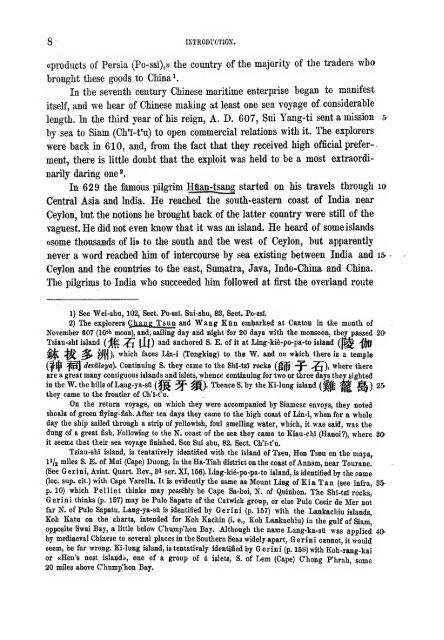Chau Ju-Kua - University of Oregon Libraries
Chau Ju-Kua - University of Oregon Libraries
Chau Ju-Kua - University of Oregon Libraries
Create successful ePaper yourself
Turn your PDF publications into a flip-book with our unique Google optimized e-Paper software.
8<br />
;<br />
IXTRODl'CTION.<br />
«products <strong>of</strong> Persia (Po-ssi),» the country <strong>of</strong> the majority <strong>of</strong> the traders who<br />
brought these goods to China ^<br />
In the seventh century Chinese maritime enterprise began to manifest<br />
itself, and we hear <strong>of</strong> Chinese making at least one sea voyage <strong>of</strong> considerable<br />
length. In the third year <strong>of</strong> his reign, A. D. 607, Sui Yang-ti sent a mission 5<br />
by sea to Siam (Ch'i-t'u) to open commercial relations with it. The explorers<br />
were back in 610, and, from the fact that they received high <strong>of</strong>ficial prefer-<br />
ment, there is little doubt that the exploit was held to be a most extraordi-<br />
narily daring one*.<br />
In 629 the famous pilgrim Hfian-tsang started on his travels through lo<br />
Central Asia and India. He reached the south-eastern coast <strong>of</strong> India near<br />
Ceylon, but the notions he brought back <strong>of</strong> the latter country were still <strong>of</strong> the<br />
vaguest. He did not even know that it was an island. He heard <strong>of</strong> some islands<br />
ftsome thousands <strong>of</strong> li» to the south and the west <strong>of</strong> Ceylon, but apparently<br />
never a word reached him <strong>of</strong> intercourse by sea existing between India and i&<br />
Ceylon and the countries to the east, Sumatra, Java, Indo-China and China.<br />
The pilgrims to India who succeeded him followed at first the overland route<br />
1) See Wei-shu, 102, Sect. Po-ssi. Sui-shu, 83, Sect. Po;Ssi.<br />
2) The explorers Chan p r Tsnn and Wang Kfln embarked at Canton in the month <strong>of</strong><br />
November 607 (lO^i^ moon), and, sailing day and night for 20 days with the monsoon, they passed 201<br />
Tsiau-shl island (^^ ^ ijj) and anchored S. E. <strong>of</strong> it at Ling-kiS-po-pa-to island (1^ Ahg<br />
'^ ^t ^ fM\ )' ^^^'^^ ia.ces Lin-i (Tongking) to the W. and on which there is a temple<br />
(^$ ^\ 'l^i-'"^''y")- Continuing S. they came to the ShMzi rocks (0)^ -^ '^\<br />
where there<br />
are a great many contiguous islands and islets, whence continuing for two or three days they sighted<br />
in the W. the hills <strong>of</strong> Lang-ya-stt (^g ^ ^). Thence S. by the Ki-lung island (^ W, ^) ^^<br />
they came to the frontier <strong>of</strong> Ch'i-t'u.<br />
On the return voyage, on which ihey were accompanied by Siamese envoys, they noted<br />
shoals <strong>of</strong> green flying-fish. After ten days they came to the high coast <strong>of</strong> Lin-i, when for a whole<br />
day the ship sailed through a strip <strong>of</strong> yellowish, foul smelling water, which, it was said, was the<br />
dung <strong>of</strong> a great fish. Following to the N. coast <strong>of</strong> the sea they came to Kiau-chii (Hanoi?), where SO<br />
it seems that their sea voyage finished. See Sui shu, 82. Sect. Ch'i-t'u.<br />
Tsiau-shi island, is tentatively identified with the island <strong>of</strong> Tseu, Hon Tseu on the maps,<br />
IV2 miles S. E. <strong>of</strong> Mui (Cape) Duong, in the Ha-Tinh district on the coast <strong>of</strong> Annam, near Tourane.<br />
(See Gerini, A^iat. Quart. Eev.,34 ser.XI, 156). Ling-kie-po-pa-to island, is identified by the same<br />
(loc. sup. cit.) with Cape Varella. It is evidently the same as Mount Ling <strong>of</strong> Ki a Tan (see infra, So-<br />
p. 10) which Pelliot thinks may possibly be Cape Sa-hoi, N. <strong>of</strong> Quinhon. The Shi-tzi rocks,<br />
Gerini thinks (p. 157) may be Pulo Sapatu <strong>of</strong> the Catwick group, or else Pulo Cecir de Mer not<br />
far N. <strong>of</strong> Pulo Sapatu. Lang-ya-stt is identified by Gerini (p. 157) with the Lankachiu islands,<br />
Koh Katu on the charts, intended for Koh Kachin (i. e., Koh Lankachiu) in the gulf <strong>of</strong> Siam<br />
opposite Swai Bay, a little below C'hump'hon Bay. Although the name Lang-ka-stt was applied 40-<br />
by mediaeval Chinese to several places in the Southern Seas widely apart, G erini cannot, it would<br />
seem, be far wrong. Ki-lung island, is tentativaly identified by Gerini (p. 158) with Koh-rang-kai<br />
oir ((Hen's nest island)), one <strong>of</strong> a group <strong>of</strong> 4 islets, S. <strong>of</strong> Lem (Cape) C'hong P'hrah, some<br />
20 miles above C'hump'hon Bay.

















